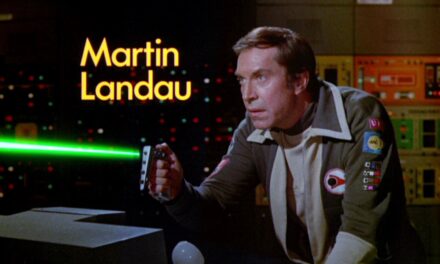
In the past year as researcher on the Warwick and De Montfort Universities AHRC project A History of Television for Women in Britain (1947-89) I’ve been thinking a lot about women and situation comedy, and watching a lot of women in situation comedy. Women’s historical role in British sitcom has been critically and popularly regarded as both limited and limiting, conforming to a handful of well-worn stereotypes, such as those exemplified by the pairing in Are You Being Served? of Wendy Richard’s glamorous blonde dolly bird Miss Brahms and Mollie Sugden’s bouffant battleaxe Mrs Slocombe.

Other options seem to be either supportive wives such as June Medford (June Whitfield pre her 1990s Absolutely Fabulous reinvention), stoically putting up with accident-prone husband Terry’s (Terry Scott) home and workplace disasters in Terry and June (1979),

or resourceful managing mother figures such as Bread’s matriarch Nellie Boswell (Jean Boht) who held home and family together in 1980s Liverpool.

Yet, exploring the representation of women in situation comedy over a forty‑year period reveals that, far from being deployed solely as comedy foils or long suffering partners, women have frequently been cast in leading roles very much at the heart of the comic action. In this post I’d like to consider one such actress, Penelope Keith, who played leading roles in a diverse range of popular television sitcoms spanning the 1970s to the 1990s and who is a key figure in any consideration of women and television comedy. Aside from Frances Gray’s excellent study of funny women, Women and Laughter (1994) in which she engages with Keith’s key TV sitcom personae, the range, breadth and complexity of the characters and situations which Keith’s comedy career has encompassed have been critically neglected and need to be reinstated in any discourses surrounding women and sitcom. Keith’s success in television comedy challenges the notion that situation comedy is a male dominated realm with little space for women; a genre in which they are frequently confined to subsidiary or supporting roles.
What is significant about Keith’s television comedy performances are the strong, confident and assertive women that she customarily plays. These women are not necessarily always likeable, nor are they out to please, and they are the equal of the men they encounter. Additionally, Keith’s distinctive physicality is integral to the characters she plays, the performances that she delivers and her relationships with other  characters. She does not conform to any conventional standards of actress ‘prettiness’ but in the roles which she plays she is nevertheless most often attractive and vivacious. She uses her tall, slim figure to advantage, appearing dignified, elegant or authoritative asthe situation requires. As Gray says of her performance as Audrey fforbes-Hamilton in To The Manor Born, “Her upright carriage in crowd scenes often gives the impression that she is the tallest person in the room” (Gray, 100:1994). It is interesting to compare Keith’s strategic use of height in her comedy with that of another tall funny woman, Miranda Hart. Hart’s height is also integral to her performance, although in her case it is often as disadvantage or obstacle. While her physical clowning can be both joyful and disruptive there is also underlying anxiety and embarrassment; implicit apology for being a tall woman. For Keith’s characters being a tall funny woman is no barrier, to being also successful, sexy and in control.
characters. She does not conform to any conventional standards of actress ‘prettiness’ but in the roles which she plays she is nevertheless most often attractive and vivacious. She uses her tall, slim figure to advantage, appearing dignified, elegant or authoritative asthe situation requires. As Gray says of her performance as Audrey fforbes-Hamilton in To The Manor Born, “Her upright carriage in crowd scenes often gives the impression that she is the tallest person in the room” (Gray, 100:1994). It is interesting to compare Keith’s strategic use of height in her comedy with that of another tall funny woman, Miranda Hart. Hart’s height is also integral to her performance, although in her case it is often as disadvantage or obstacle. While her physical clowning can be both joyful and disruptive there is also underlying anxiety and embarrassment; implicit apology for being a tall woman. For Keith’s characters being a tall funny woman is no barrier, to being also successful, sexy and in control.
Her lead sitcom roles have encompassed suburban super-snob, aristocratic landowner, MP, barrister,

editorial director, and a fortysomething manager of a building firm having a baby with her twenty‑six‑year‑old boyfriend.

In the rest of this post I’d like to consider briefly a selection of these roles which illustrate something of the breadth and variety of her television comedy performances.
Penelope Keith first came to public prominence, and for many stole the show, in her role as Margo Leadbetter in The Good Life (BBC 1975), in which Tom and Barbara Good (Richard Briars and Felicity Kendal) opted out of the 1970s consumer rat‑race to become self-sufficient in Surbiton. Superficially next‑door neighbour Margo seems to conform to a host of traditional female sitcom stereotypes. She is at first sight a rather superficial and stuck‑up suburban housewife, obsessed with appearances and social status. Keith’s height and bearing are crucial to this comic characterisation. Margo is statuesque, highly‑groomed and immaculately turned out in voguish mid‑1970s  chic: flowing maxi dresses, turbans and stylish trouser suits. This rather too carefully constructed presentation of self is however contrasted with Margo’s frequent comedic misadventures and comeuppances, which expose the brittleness of this manufactured persona. “Keith makes us aware just how Margo has constructed her lady-of -the-manor persona and how fragile that construct is” (Gray, 99:1994). Indeed her nuanced portrayal of Margo’s triumphs and humiliations serves to highlight Margo’s awareness of her own flaws, most notably a lack of a sense of humour, and her ability even to admit to them (on occasion) making her a rounded and even sympathetic character rather than the one-dimensional, suburban harridan she might have been.
chic: flowing maxi dresses, turbans and stylish trouser suits. This rather too carefully constructed presentation of self is however contrasted with Margo’s frequent comedic misadventures and comeuppances, which expose the brittleness of this manufactured persona. “Keith makes us aware just how Margo has constructed her lady-of -the-manor persona and how fragile that construct is” (Gray, 99:1994). Indeed her nuanced portrayal of Margo’s triumphs and humiliations serves to highlight Margo’s awareness of her own flaws, most notably a lack of a sense of humour, and her ability even to admit to them (on occasion) making her a rounded and even sympathetic character rather than the one-dimensional, suburban harridan she might have been.
In To The Manor Born (BBC 1979), Keith plays bankrupt widow Audrey fforbes‑Hamilton, forced to sell the family country estate to self-made Czech millionaire Richard de Vere (Peter Bowles). The series was in essence a star vehicle for Keith, sourced as a reward for her success in The Good Life. In Audrey, as writer Peter Spence remarked in Comedy Connections (BBC 2006), we find “the woman who actually is everything that Margo aspires to be”. Audrey is ‘old money’ (albeit currently impoverished), the upholder of centuries of aristocratic tradition and privilege. She is also another potentially unsympathetic character, possessed of a set of rigidly held conservative (with a small and large C) values. She can be selfish and domineering, blithely assuming the rightness of her views and opinions. Yet she is also a strong and in many ways courageous woman, fighting to re-establish some kind of life and identity after losing her home and her much  cherished status in the community. What gives Audrey warmth and a degree of vulnerability is her relationship with the entrepreneurial meritocrat de Vere. He constantly challenges her, making her confront her prejudices and usually defeating her attempts to expose him as lacking in culture and intelligence. Gray observes that de Vere “is charming, courteous and recoups his occasional social gaffes with enviable grace” (Gray, 101:1994). Indeed it was the romantic relationship that develops between Audrey and de Vere which at the time according to Spence was largely responsible for the programme’s regular audiences of over twenty million. What is notable is that Keith, at forty, is cast as a romantic lead in a television comedy which has at its centre a mature woman as both desiring subject and object of desire.
cherished status in the community. What gives Audrey warmth and a degree of vulnerability is her relationship with the entrepreneurial meritocrat de Vere. He constantly challenges her, making her confront her prejudices and usually defeating her attempts to expose him as lacking in culture and intelligence. Gray observes that de Vere “is charming, courteous and recoups his occasional social gaffes with enviable grace” (Gray, 101:1994). Indeed it was the romantic relationship that develops between Audrey and de Vere which at the time according to Spence was largely responsible for the programme’s regular audiences of over twenty million. What is notable is that Keith, at forty, is cast as a romantic lead in a television comedy which has at its centre a mature woman as both desiring subject and object of desire.
Sweet Sixteen (BBC1983), a series which seems to have disappeared almost completely from popular memory and public record, has Keith in another romantic role, albeit in rather different and, within its historical context, rather more controversial circumstances. Gray’s assertion that Keith’s characters, strong in so many ways, don’t challenge “their lives of blameless sexual conformity” (Gray, 107:1994) is overturned by Sweet Sixteen. Keith plays the forty‑two‑year‑old Helen Walker, owner of a building firm, who also happens to be in a relationship with her firm’s twenty‑six‑year‑old architect. In the first episode she discovers that she is having his baby. As a single‑mum‑to‑be, in love with a younger man, Keith’s character is far not only from popular perceptions of what might be expected of her but indeed very far from the narrow perspectives identified at the beginning of this piece about what we might expect of women in British TV sitcoms. Walker is a complex and driven character, juggling unexpected pregnancy, a demanding career and the social pressures of being involved with a significantly younger man. Foregrounding an older career woman and her younger lover, especially in a sitcom, is singular for the period. Although there is now far greater public acceptance of younger men and older women in relationships, it is never the less worth highlighting that in the BBC’s sitcom Me and Mrs Jones (2012), having a relationship with a man twenty years younger is presented as definitely problematic. Sweet Sixteen made some thirty years earlier in comparison looks to be the more progressive text.

I’d like to conclude by considering No Job for a Lady (ITV 1990), in which Keith plays Jean Price, a newly elected Labour MP. The series follows Price’s early experiences in dealing with life in the House of Commons. Significant here is that Keith plays a left‑wing and actively feminist character, in marked contrast to any easy categorisations of Keith as someone who simply plays ‘posh’. Indeed, the series tackles the challenges Price faces in  dealing with the male‑dominated House of Commons, concentrating on her ongoing struggles to negotiate the implicit and explicit sexism of the House and her desire to make sure that as a woman she does her best to represent women’s interests there. At the same time the common‑sense approach that Price brings to the House, born of her ongoing active involvement in local politics and practical experiences as a mother with a family to consider, stands in marked contrast to many of the out‑of‑touch and privileged male MPs she encounters. Much of the comedy ensues as Jean attempts to negotiate the arcane practices and conventions of the House, bringing her into conflict with those – generally men – who would wish to keep things exactly as they are. The series brings out again and again the isolation of the female MP. Whilst it would be debatable to suggest that No Job for a Ladyis a feminist comedy, nevertheless it is a piece which presents events from the perspective of a woman MP and whose approach to the situations which she encounters are governed by her clear feminist perspective and agenda.
dealing with the male‑dominated House of Commons, concentrating on her ongoing struggles to negotiate the implicit and explicit sexism of the House and her desire to make sure that as a woman she does her best to represent women’s interests there. At the same time the common‑sense approach that Price brings to the House, born of her ongoing active involvement in local politics and practical experiences as a mother with a family to consider, stands in marked contrast to many of the out‑of‑touch and privileged male MPs she encounters. Much of the comedy ensues as Jean attempts to negotiate the arcane practices and conventions of the House, bringing her into conflict with those – generally men – who would wish to keep things exactly as they are. The series brings out again and again the isolation of the female MP. Whilst it would be debatable to suggest that No Job for a Ladyis a feminist comedy, nevertheless it is a piece which presents events from the perspective of a woman MP and whose approach to the situations which she encounters are governed by her clear feminist perspective and agenda.
This brief examination of Keith’s work demonstrates her strong resonant female presence in British television comedy. Penelope Keith is just one of many actresses who whose similarly significant work in television comedy is equally neglected. This blog could very usefully have considered the work of, for example, Felicity Kendal, Mollie Sugden, Maureen Lipman or Wendy Craig. For it is in the exploration of the television comedy careers of women such as Keith or those just mentioned that we can begin to reinsert and reposition women into critical histories of British television comedy, creating full, rich and authoritative histories which acknowledge women’s contributions and their importance.

Mary Irwin is currently the postdoctoral research fellow on a three-year AHRC research project “A History of Television for Women in Britain 1947-89” run jointly by Warwick and De Montfort Universities. She has written and published on early women’s television and is currently researching women’s relationships with television romantic situation comedy. Mary also has research interests in television documentary and television drama. Most recently she has contributed to the first extended account of the BBC series Life on Mars – Life on Mars: From Manchester to New York (University of Wales Press, 2012).





